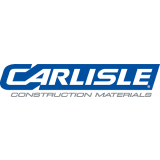This informal CPD article Vapour Control Layer vs Vapour Barrier was provided by CARLISLE Construction Materials, a globally diversified company offering Waterproofing solutions for flat roofs, facades, buildings and landscapes.
What is a Vapour Control Layer (VCL)?
In simple terms, this is typically a plastic or foil layer on the inner face of the building which is used to reduce moisture flow into and through the walls, roof or floor. This is to prevent damaging levels of condensation occurring in the fabric of the building which in turn would cause decay in timber, corrosion in metals or frost damage in masonry.
Damage from water condensation due to water vapour movement (called “water vapour drive”) can wreak havoc on even the sturdiest of built structures, and threaten the effectiveness of insulation.
Vapour control membranes are frequently used in flat roof construction to prevent moist air from the inside of the building condensing onto the roof assembly and potentially causing damage to materials. These products are an important way to preserve the thermal efficiency of roof insulation, and so make up a crucial part of protecting the comfort and energy efficiency of a home or commercial building.
To work effectively, the vapour membrane must also be warm enough to stay above the dew point on the exterior side, which means sufficient insulation must be installed over the membrane to maintain the temperature no matter the weather outside.
Vapour Control for Flat Roofs
A vapour control layer helps to shield the building from the consequences of condensation. Condensation is generated when warm moist air rises and condenses into a liquid on contact with the cooler areas above the insulation. The notion behind a vapour control layer is to install it on the room side of the insulation so it stops the passage of warm moist air entering the structure.
A VCL is a very important component in a warm roof build up acting as one of the protective layers that minimises the amount of warm moist air that comes into a construction aspect. A VCL in conjunction with the correct use of venting and membranes will essentially eradicate the risk of interstitial condensation. It is the two design fundamentals working collectively that greatly reduce the destructive effects of condensation on the structure.
A VCL prevents damp and mould which generally, helps to prevent major respiratory problems, according to the NHS. As well as major health ramifications, condensation can also cause structural problems, weakening wooden framed structures and corroding other materials. An additional major benefit of the VCL is that it will prevent installed insulation becoming damp and losing its thermal properties. A VCL on a warm flat roof sits between the roof decking and the insulation.
Differences between Vapour Control Layers and Vapour Barrier
A polythene vapour control layer limits the movement of air and water vapour through a membrane, so a vapour control layer is air permeable, or vapour permeable. Comparatively, a vapour barrier prevents any movement of vapour or air occurring through the building, instead of just limiting it to a controlled level.
Vapour control layers differ from vapour barriers in that they are designed to slow the flow of moisture and not block it completely. Vapour control layers are also airtight and generally used as an airtight layer to make buildings airtight. Vapour Barriers fully prevent the movement of vapour and air.
VCLs effectively act only as a vapour check, whereas a Vapour Barrier fully seals the building from vapour penetration altogether, hence provides a more robust performance against the vapour movement which can cause condensation.
We hope this article was helpful. For more information from CARLISLE Construction Materials, please visit their CPD Member Directory page. Alternatively please visit the CPD Industry Hubs for more CPD articles, courses and events relevant to your Continuing Professional Development requirements.













